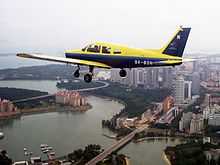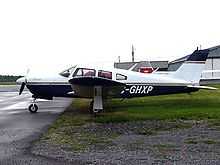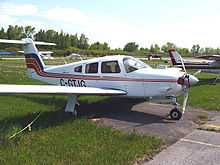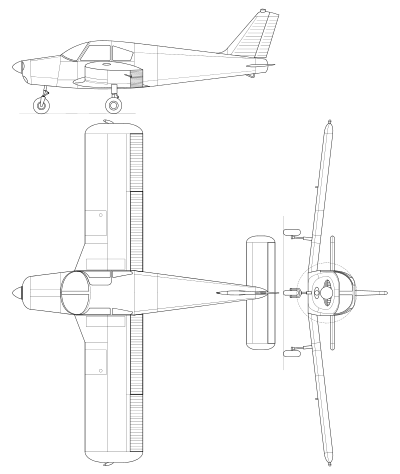Piper PA-28 Cherokee

The Piper PA-28 Cherokee is a family of light aircraft designed for flight training, air taxi, and personal use. It is built by Piper Aircraft.[2]
All members of the PA-28 family are all-metal, unpressurized, single-engined, piston-powered airplanes with low-mounted wings and tricycle landing gear. They all have a single door on the copilot side, which is entered by stepping on the wing.[2][3]
The first PA-28 received its type certificate from the Federal Aviation Administration in 1960, and the series remains in production to this day. Current models are the Arrow[4] and Archer TX and LX.[5] The Archer was discontinued in 2009, but with investment from new Piper owners Imprimis, was put back into production in 2010.[6][7][8]
The PA-28 series competes with the Cessna 172, the Grumman American AA-5 series, and the Beechcraft Musketeer.[9]
Piper has created variations within the Cherokee family by installing engines ranging from 140 to 300 hp (105-220 kW), providing turbocharging, offering fixed or retractable landing gear, fixed-pitch or constant speed propellers, and stretching the fuselage to accommodate six people. The larger, six-seat variant of the PA-28 is generally the PA-32; earlier versions were known as the "Cherokee Six", and a PA-32 version called the Saratoga was in production until 2009.[2][10]
Development

At the time of the Cherokee's introduction, Piper's primary single-engined, all-metal aircraft was the Piper PA-24 Comanche, a larger, faster aircraft with retractable landing gear and a constant-speed propeller. Karl Bergey,[11] Fred Weick and John Thorp designed the Cherokee as a less expensive alternative to the Comanche, with lower manufacturing and parts costs to compete with the Cessna 172, although some later Cherokees also featured retractable gear and constant-speed propellers.
The Cherokee and Comanche lines continued in parallel production, serving different market segments for over a decade, until Comanche production was ended in 1972, to be replaced by the Piper PA-32R family.[2]
PA-28 Cherokee






The original Cherokees were the Cherokee 150 and Cherokee 160 (PA-28-150 and PA-28-160), which started production in 1961 (unless otherwise mentioned, the model number always refers to horsepower).[2]
In 1962, Piper added the Cherokee 180 (PA-28-180) powered by a 180-horsepower (134-kW) Lycoming O-360 engine. The extra power made it practical to fly with all four seats filled (depending on passenger weight and fuel loading), and the model remains popular on the used-airplane market.[2] In 1968, the cockpit was modified to replace the "push-pull" style engine controls with levers. In addition, a third window was added to each side, giving the fuselage the more modern look seen in current production.[12]
Piper continued to expand the line rapidly. In 1963, the company introduced the even more powerful Cherokee 235 (PA-28-235), which competed favorably with the Cessna 182 for load-carrying capability. The Cherokee 235 featured a Lycoming O-540 engine derated to 235 horsepower (175 kW) and a longer wing which would eventually be used for the Cherokee Six. It included tip tanks of 17-gallon capacity each, bringing the total fuel capacity of the Cherokee 235 to 84 gallons.[2] The aircraft had its fuselage stretched in 1973 giving much more leg room in the rear. The stabilator area was increased as well. In 1973 the marketing name was changed from "235" to "Charger". In 1974 it was changed again to "Pathfinder". Production of the Pathfinder continued until 1977. There was no 1978 model year. In 1979 the aircraft was given the Piper tapered wing and the name was changed again, this time to "Dakota".[citation needed]
In 1964, the company filled in the bottom end of the line with the Cherokee 140 (PA-28-140), which was designed for training, and initially shipped with only two seats.[2] The PA-28-140 engine was slightly modified shortly after its introduction to produce 150 horsepower (112 kW), but kept the -140 name.
In 1967, Piper introduced the PA-28R-180 Cherokee Arrow. This aircraft featured a constant-speed propeller, retractable landing gear and was powered by a 180-horsepower (134-kW) Lycoming IO-360-B1E engine. A 200-hp (149-kW) version powered by a Lycoming IO-360-C1C was offered as an option beginning in 1969 and designated the PA-28R-200; the 180-hp model was dropped after 1971.[13] At the time the Arrow was introduced, Piper removed the Cherokee 150 and Cherokee 160 from production.[2][14][15]
The Arrow II came out in 1972, featuring a five-inch fuselage stretch to increase legroom for the rear-seat passengers.[13] In 1977, Piper introduced the Arrow III (PA-28R-201), which featured a semitapered wing and longer stabilator, a design feature that had previously been introduced successfully on the PA-28-181 and provided better low-speed handling. It also featured larger fuel tanks, increasing capacity from 50 to 77 gallons.[15]
The first turbocharged model, the PA-28R-201T was also offered in 1977, powered by a six-cylinder Continental TSIO-360-F engine equipped with a Rajay turbocharger. A three-bladed propeller was optional.[13]
In 1979, the Arrow was restyled again as the PA-28RT-201 Arrow IV, featuring a "T" tail that resembled the other aircraft in the Piper line at the time.[15]
In 1971, Piper released a Cherokee 140 variant called the Cherokee Cruiser 2+2. Although the plane kept the 140 designation, it was, in fact, a 150-hp plane, and was shipped mainly as a four-seat version. In 1973, the Cherokee 180 was named the Cherokee Challenger, and had its fuselage lengthened slightly and its wings widened, and the Cherokee 235 was named the Charger with similar airframe modifications.[2] In 1974, Piper changed the marketing names of some of the Cherokee models again, renaming the Cruiser 2+2 (140) simply the Cruiser, the Challenger to the Archer (model PA-28-181) and the Charger (235) to Pathfinder.[14]
Piper reintroduced the Cherokee 150 in 1974, renaming it the Cherokee Warrior (PA-28-151) and giving it the Archer's stretched body and a new, semitapered wing.[2][14]
In 1977, Piper stopped producing the Cruiser (140) and Pathfinder (235), but introduced a new 235-hp (175-kW) plane, the Dakota (PA-28-236), based on the Cherokee 235, Charger, and Pathfinder models, but with the new semitapered wing.[14]
The PA-28-201T Turbo Dakota followed the introduction of the PA-28-236 Dakota in 1979. The airframe was essentially the same as a fixed-gear Arrow III, and was powered by a turbocharged Continental TSIO-360-FB engine producing 200 hp (149 kW). The aircraft did not sell well, and production ended in 1980.[16]
In 1978, Piper upgraded the Warrior to 160 hp (119 kW) PA-28-161, changing its name to Cherokee Warrior II. This aircraft had slightly improved aerodynamic wheel fairings. Later models of the Warrior II, manufactured after July 1982, incorporated a gross weight increase to 2,440 pounds, giving a useful load over 900 pounds. This same aircraft, now available with a glass cockpit, was available as the Warrior III, and was marketed as a training aircraft.[5][17]
PA-32
In 1965, Piper developed the Piper Cherokee Six, designated the PA-32, by stretching the PA-28 design. It featured a lengthened fuselage and seating for one pilot and five passengers.[14]
Brazilian, Argentinian and Chilean production
PA-28s were built under license in Brazil as the Embraer EMB-711A and EMB-711C Corisco (PA-28R-200), EMB-711B (PA-28R-201), EMB-711T (PA-28RT-201) and EMB-711ST Corisco Turbo (PA-28RT-201T) and the EMB-712 Tupi (PA-28-181). Argentinian production was carried out by Chincul SACAIFI of San Juan, Argentina. Chincul S. A. built 960 airplanes between 1972 and 1995, including the Cherokee Archer, Dakota, Arrow, and Turbo Arrow.[18] The PA-28-236 Dakota was also assembled under license by the Maintenance Wing of the Chilean Air Force (which later became known as ENAER). By September 1982, 20 Dakotas had been assembled in Chile.[19]
New Piper Aircraft
The original Piper Aircraft company declared bankruptcy in 1991. In 1995, The New Piper Aircraft company was created. It was renamed Piper Aircraft once again in 2006. The company currently produces one variant: the 180 horsepower (134 kW) Archer LX (PA-28-181).[20]
Design
Wing
Originally, all Cherokees had a constant-chord, rectangular planform wing, popularly called the "Hershey Bar" wing because of its resemblance to the convex, rectangular chocolate bar.
Beginning with the Warrior in 1974, Piper switched to a semitapered wing with the NACA 652-415 profile and a 2-foot-longer (0.61 m) wingspan. The constant chord is maintained from the root to mid-wing, at which point a tapered section sweeping backwards on the leading edge continues until the tip. Both Cherokee wing variants have an angled wing root; i.e., the wing leading edge is swept forward as it nears the fuselage body, rather than meeting the body at a perpendicular angle.
The documented takeoff distance, cruise speed, and landing distance of Cherokees of the same horsepower with different wing types is very similar and some of the differences that do exist in later taper-wing models can be attributed to better fairings and seals rather than the different wing design. The Hershey Bar wing design is not markedly inferior to the tapered design, and in some ways is quite advantageous. As Piper Cherokee designer John Thorp says: "Tapered wings tend to stall outboard, reducing aileron effectiveness and increasing the likelihood of a rolloff into a spin." [21]
As Peter Garrison further explains: "To prevent tip stall, designers have resorted to providing the outboard portions of tapered wings with more cambered airfoil sections, drooped or enlarged leading edges, fixed or automatic leading edge slots or slats, and, most commonly, wing twist or "washout". The trouble with these fixes is that they all increase the drag, canceling whatever benefit the tapered wing was supposed to deliver in the first place."[21]
Flight controls
For the Cherokee family, Piper used their traditional flight control configuration. The horizontal tail is a stabilator with an antiservo tab (sometimes termed an antibalance tab). The antiservo tab moves in the same direction of the stabilator movement, making pitch control "heavier" as the stabilator moves out of the trimmed position. Flaps can extend up to 40°, but are considerably smaller, and arguably less effective, than the flaps on a Cessna 172. Normally, 25° flaps are used for a short- or soft-field takeoff. The ailerons, flaps, stabilator, and stabilator trim are all controlled using cables and pulleys.[22]
In the cockpit, all Cherokees use control yokes rather than sticks, together with rudder pedals.[22] The pilot operates the flaps manually using a Johnson bar located between the front seats: for zero degrees the lever is flat against the floor and is pulled up to select the detent positions of 10°, 25° and 40°.[22]
Older Cherokees use an overhead crank for stabilator trim (correctly called an antiservo tab), while later ones use a trim wheel on the floor between the front seats, immediately behind the flap bar.[22]
All Cherokees have a brake lever under the pilot side of the instrument panel. Differential toe brakes on the rudder pedals were an optional add-on for earlier Cherokees, and became standard with later models.[22]
Some earlier Cherokees used control knobs for the throttle, mixture, and propeller advance (where applicable), while later Cherokees use a collection of two or three control levers in a throttle quadrant.[22]
Cherokees normally include a rudder trim knob, which actually controls a set of springs acting on the rudder pedals rather than an external trim tab on the rudder — in other words, the surface is trimmed by control tension rather than aerodynamically.[22]
Variants
- PA-28-140 Cherokee Cruiser
- Two-place, fixed landing gear landplane, Lycoming O-320-E2A engine of 150 hp (112 kW), gross weight 1,950 lb (885 kg). First certified on 14 February 1964. Approved as a 2,150 lb (975 kg) gross weight four place aircraft on 17 June 1965.[15]
- PA-28-150 Cherokee
- Four-place, fixed landing gear landplane, Lycoming O-320-A2B or O-320-E2A engine of 150 hp (112 kW), gross weight 2,150 lb (975 kg). First certified on 2 June 1961.[15]
- PA-28-151 Cherokee Warrior
- Four-place, fixed landing gear landplane, Lycoming O-320-E3D engine of 150 hp (112 kW), gross weight 2,325 lb (1,055 kg). First certified on 9 August 1973. Changes from the PA-28-150 include a tapered wing.[15]
- PA-28-160 Cherokee
- Four-place, fixed landing gear landplane, Lycoming O-320-B2B or O-320-D2A engine of 160 hp (119 kW), gross weight 2,200 lb (998 kg). First certified on 31 October 1960.[15]
- PA-28-161 Warrior II
- Four-place, fixed landing gear landplane, Lycoming O-320-D3G or O-320-D2A engine of 160 hp (119 kW), gross weight 2,325 lb (1,055 kg). First certified on 2 November 1976. Changes from the PA-28-160 include a tapered wing. Certified on 1 July 1982 for gross weight of 2,440 lb (1,107 kg).[15]
- PA-28-161 Warrior III
- Four-place, fixed landing gear landplane, Lycoming O-320-D3G engine of 160 hp (119 kW), gross weight 2,440 lb (1,107 kg). First certified on 1 July 1994.[15]
- PA-28-180 Cherokee
- Four-place, fixed landing gear landplane, Lycoming O-360-A3A or O-360-A4A engine of 180 hp (134 kW), gross weight 2,400 lb (1,089 kg). First certified on 3 August 1962.[15]
- PA-28-180 Archer
- Four-place, fixed landing gear landplane, Lycoming O-360-A4A or O-360-A4M engine of 180 hp (134 kW), gross weight 2,450 lb (1,111 kg). First certified on 22 May 1972. Changes from the PA-28-180 Cherokee include a five inch fuselage extension, wing span increase, larger horizontal tail, gross weight increase and other minor changes.[15]
- PA-28-181 Archer II
- Four-place, fixed landing gear landplane, Lycoming O-360-A4M or O-360-A4A engine of 180 hp (134 kW), gross weight 2,550 lb (1,157 kg). First certified on 8 July 1975. Changes from the PA-28-180 include a tapered wing.[15]
- PA-28-181 Archer III
- Four-place, fixed landing gear landplane, Lycoming O-360-A4M engine of 180 hp (134 kW), gross weight 2,550 lb (1,157 kg). First certified on 30 August 1994.[15]
- PA-28-201T Turbo Dakota
- Four-place, fixed landing gear landplane, turbocharged Continental TSIO-360-FB, engine of 200 hp (149 kW), gross weight 2,900 lb (1,315 kg). First certified on 14 December 1978.[15]
- PA-28-235 Cherokee Pathfinder
- Four-place, fixed landing gear landplane, Lycoming O-540-B2B5, O-540-B1B5, or O-540-B4B5 engine of 235 hp (175 kW), gross weight 2,900 lb (1,315 kg). First certified on 15 July 1963.[15]
- PA-28-235 Cherokee Pathfinder
- Four-place, fixed landing gear landplane, Lycoming O-540-B4B5 engine of 235 hp (175 kW), gross weight 3,000 lb (1,361 kg). First certified on 9 June 1972. Changes from the 1963 certified PA-28-235 Cherokee Pathfinder include a five inch fuselage extension, wing span increase, larger horizontal tail, gross weight increase and other minor changes.[15]
- PA-28-236 Dakota
- Four-place, fixed landing gear landplane, Lycoming O-540-J3A5D engine of 235 hp (175 kW), gross weight 3,000 lb (1,361 kg). First certified on 1 June 1978. Changes from the 1972 certified PA-28-235 Cherokee Pathfinder include tapered wing.[15]
- PA-28S-160 Cherokee
- Four-place, fixed landing gear seaplane, Lycoming O-320-D2A engine of 160 hp (119 kW), gross weight 2,140 lb (971 kg). First certified on 25 February 1963.[15]
- PA-28S-180 Cherokee
- Four-place, fixed landing gear seaplane, Lycoming O-360-A3A or O-360-A4A engine of 180 hp (134 kW), gross weight 2,222 lb (1,008 kg). First certified on 10 May 1963.[15]
- PA-28R-180 Arrow
- Four-place, retractable landing gear landplane, Lycoming IO-360-B1E engine of 180 hp (134 kW), gross weight 2,500 lb (1,134 kg). First certified on 8 June 1967.[15]
- PA-28R-200 Arrow
- Four-place, retractable landing gear landplane, Lycoming IO-360-C1C engine of 200 hp (149 kW), gross weight 2,600 lb (1,179 kg). First certified on 16 January 1969.[15]
- PA-28R-200 Arrow II
- Four-place, retractable landing gear landplane, Lycoming IO-360-C1C or C1C6 engine of 200 hp (149 kW), gross weight 2,650 lb (1,202 kg). First certified on 2 December 1971. Changes from the 1969 certified PA-28R-200 Arrow include a five inch fuselage extension, wing span increase, larger horizontal tail, gross weight increase and other minor changes.[15]
- PA-28R-201 Arrow III
- Four-place, retractable landing gear landplane, Lycoming IO-360-C1C6 engine of 200 hp (149 kW), gross weight 2,750 lb (1,247 kg). First certified on 2 November 1976.[15]
- PA-28R-201T Turbo Arrow III
- Four-place, retractable landing gear landplane, turbocharged Continental TSIO-360-F or TSIO-360-FB engine of 200 hp (149 kW), gross weight 2,900 lb (1,315 kg). First certified on 2 November 1976.[15]
- PA-28RT-201 Arrow IV
- Four-place, retractable landing gear landplane, Lycoming IO-360-C1C6 engine of 200 hp (149 kW), gross weight 2,750 lb (1,247 kg). First certified on 13 November 1978. Features a T tail.[15]
- PA-28RT-201T Turbo Arrow IV
- Four-place, retractable landing gear landplane, turbocharged Continental TSIO-360-FB engine of 200 hp (149 kW), gross weight 2,900 lb (1,315 kg). First certified on 13 November 1978. Features a T tail.[15]
Operators
The Cherokee series has been popular with private owners and flying clubs, with over 32,000 delivered.
Military operators
- Argentine Coast Guard[23]
- Colombian National Armada - Retired.[24]
- Finnish Air Force - 14 x Cherokee Arrow 200[25] Retired 2005[citation needed]
- Honduran Air Force[citation needed]
- Qatar Emiri Air Force[26]
Accidents and incidents
- September 9, 1969, Allegheny Airlines Flight 853, a Douglas DC-9-31, collided with a Piper PA-28-181 Archer over Fairland, Indiana, killing all aboard both planes.[27]
- August 28, 1972, Prince William of Gloucester, was killed along with the copilot of his Piper Cherokee Arrow after crashing shortly after takeoff from Halfpenny Green in Staffordshire, England,[28] in an air race.[29]
- August 31, 1986, Aeroméxico Flight 498, a Douglas DC-9-32, collided with a Piper PA-28-181 Archer, owned by William Kramer, over Cerritos, California, killing all 67 people aboard both planes and 15 people on the ground. It was the worst air disaster in the history of Los Angeles,[30] and resulted in regulatory changes requiring all airliners to be equipped with a traffic collision avoidance system (TCAS) and all light aircraft operating in terminal control areas to be equipped with a mode C transponder.[31]
- February 18, 2010, Andrew Joseph Stack III deliberately flew his Piper PA-28-236 Dakota into Building 1 of the Echelon office complex in Austin, Texas,[32] in an apparent revenge attack on the Internal Revenue Service office located there.
- November 17, 2011, a PA-28-180 crash four miles south of Perryville, Arkansas claimed the life of Oklahoma State University head women's basketball coach Kurt Budke and assistant coach Miranda Serna, along with the pilot and another passenger.[33][34]
Aircraft on display
- Siegerland Airport - Piper PA-28-140 Cherokee Cruiser D-ECOF[35]
Specifications (1964 model PA-28-140 Cherokee 140)

Data from Piper Aircraft Owner's Handbook[22]
General characteristics
- Crew: one pilot
- Capacity: three passengers
- Length: 23.3 feet (7.16 m)
- Wingspan: 30.0 feet (9.2 m)
- Height: 7.3 feet (2.25 m)
- Wing area: 160 sq ft (15.14 m²)
- Airfoil: NACA 652-415
- Empty weight: 1201 lb (544 kg)
- Loaded weight: 2150 lb (975 kg)
- Useful load: 949 lb (430 kg)
- Max. takeoff weight: 2150 lb (975 kg)
- Powerplant: 1 × Lycoming O-320-E2A Sensenich M74DM propeller, 150 hp (113 kW)
- Propeller diameter: 74 inches (1.9 m)
Performance
- Maximum speed: 123 knots (142 mph, 230 km/h)
- Cruise speed: 108 knots (124 mph, 200 km/h)
- Stall speed: 47 knots (54 mph, 87 km/h)
- Range: 465 nm (535 sm, 867 km)
- Service ceiling: 14,300 feet (4400 m)
- Rate of climb: 660 ft/min (3.4 m/s)
- Wing loading: 13.4 lb/sq ft (64.4 kg/m2)
- Power/mass: 14.3 lb/hp (0.116 kW/kg)
Avionics
factory standard 1964, none
Notable appearances in media
See also
- Related development
- Aircraft of comparable role, configuration and era
- Beechcraft Musketeer
- Cessna 172
- Cessna 177
- Cessna 182
- Diamond DA40
- Socata Horizon
- Socata TB
- Grumman AA-5 Traveller, Cheetah, and Tiger
- Beagle Pup
- Robin DR400
- SIAI-Marchetti S.205
- Wassmer WA-51 Pacific
- Related lists
- List of airliners
- List of civil aircraft
References
- Sources
- ↑ Taylor, John W. R. (1961). Jane's All The World's Aircraft 1961–62. London: Sampson Low, Marston & Company, Ltd. p. 305.
- ↑ 2.0 2.1 2.2 2.3 2.4 2.5 2.6 2.7 2.8 2.9 2.10 Plane and Pilot: 1978 Aircraft Directory, pages 62-64. Werner & Werner Corp, Santa Monica CA, 1977. ISBN 0-918312-00-0
- ↑ Twombly, Mark R. (undated). "Training Aircraft Review: The Piper Warrior III". Archived from the original on 2008-01-29. Retrieved 2008-02-06.
- ↑ New Piper Aircraft (undated). "Welcome to the Arrow". Retrieved 2008-02-06.
- ↑ 5.0 5.1 New Piper Aircraft (undated). "Welcome to the Archer LX". Retrieved 25 February 2011.
- ↑ Piper Aircraft (2009). "Discontinued Aircraft". Retrieved 2009-06-03.
- ↑ Niles, Russ (July 2009). "Piper Likes Future With Imprimis". Retrieved 2009-07-29.
- ↑ Piper Aircraft (2011). "Archer TX". Retrieved 7 June 2011.
- ↑ Collins, Richard L. (May 2005). "Flying Four By Fours". Retrieved 2008-02-06.
- ↑ New Piper Aircraft (undated). "Welcome to the Saratoga II TC". Retrieved 2008-02-06.
- ↑ "Karl Bergey, Chairman & CEO". September 25, 2007. Archived from the original on 2007-07-09. Retrieved 2007-09-25.
- ↑ Gilbert, James (February 1968). "Pilot Report:The Cherokee D". Flying 82 (2): 44–48.
- ↑ 13.0 13.1 13.2 Twombly, Mark: "Piper Arrow," AOPA Pilot, June 1986.
- ↑ 14.0 14.1 14.2 14.3 14.4 Airliners.net (undated). "The Piper PA-28 Cherokee Series". Retrieved 2008-02-06.
- ↑ 15.0 15.1 15.2 15.3 15.4 15.5 15.6 15.7 15.8 15.9 15.10 15.11 15.12 15.13 15.14 15.15 15.16 15.17 15.18 15.19 15.20 15.21 15.22 15.23 15.24 15.25 Federal Aviation Administration (January 2009). "TYPE CERTIFICATE DATA SHEET NO. 2A13 Revision 49". Retrieved 2010-02-24.
- ↑ Taylor, John W.R.: Jane's Pocket Book Light Aircraft Revised Edition, page 171. Jane's Publishing Company Ltd, 1982. ISBN 0-7106-0195-6
- ↑ Piper Aircraft (2009). "Warrior III Price and Equipment (plus PDF specs)". Retrieved 2009-06-01.
- ↑ Pereira de Andrade, Roberto.: Enciclopédia de Aviões Brasileiros,Editora Globo, 1997. ISBN 85-250-2137-7
- ↑ 19.0 19.1 Taylor, John W.R. Jane's All The World's Aircraft 1982–83. London: Jane's Yearbooks, 1982. ISBN 0-7106-0748-2. pp. 31, 438.
- ↑ "Piper.com main page". Retrieved 5 May 2011.
- ↑ 21.0 21.1 Garrison, Peter (January 2003). "Rectangular Wings". Retrieved 2009-12-26.
- ↑ 22.0 22.1 22.2 22.3 22.4 22.5 22.6 22.7 Piper Aircraft: Cherokee 140 PA-28-140 Owner's Handbook. Piper Aircraft Corporation publication 753 584, February 1964, Revised May 27, 1977
- ↑ "Argentine Coast Guard". Retrieved 2013-08-07.
- ↑ "Colombia Navy" (Web). Retrieved 2013-08-05.
- ↑ Andrade 1982, p. 64
- ↑ "Qatar" (PDF). Retrieved 2013-03-08.
- ↑ "Aviation Safety Network: Allegheny Airlines Flight 853". Aviation-safety.net. 1969-09-09. Retrieved 2013-03-08.
- ↑ "1972: Prince William killed in plane crash". BBC News. 1963-08-28. Retrieved 2013-03-08.
- ↑ "Prince William dies in air crash". Expressandstar.com. Retrieved 2013-03-08.
- ↑ "Aviation Safety Network: Aeromexico Flight 498". Aviation-safety.net. 1986-08-31. Retrieved 2013-03-08.
- ↑ Larry Gerber, AP, "1986 Cerritos crash changed the way we fly," The Intelligencer Record (Doylestown, Pa.), September 1, 1996, p A-13
- ↑ "Austin American Statesman Coverage of Plane Crash". Statesman.com. 2010-02-18. Retrieved 2013-03-08.
- ↑ Haisten, Bill and Kelly Hines (18 November 2011). "OSU's Kurt Budke, assistant killed in plane crash". Tulsa World. Retrieved 18 November 2011.
- ↑ Niles, Russ (20 November 2011). "OSU Plane Hit Nose-First, Weather Not A Factor". AVWeb. Retrieved 21 November 2011.
- ↑ "Photos: Piper PA-28-140 Cherokee Cruiser Aircraft Pictures". Airliners.net. 2010-08-21. Retrieved 2013-04-28.
- Bibliography
- Andrade, John (1982). Militair 1982. London: Aviation Press Limited. ISBN 0907898017.
External links
| Wikimedia Commons has media related to Piper PA-28 Cherokee. |
- Official website
- Piper Cherokee and Arrow Safety Highlights Report by AOPA on safety and accidents for PA-28 and PA-28R
| ||||||||
| ||||||||||||||